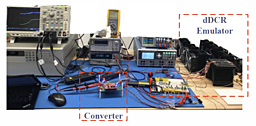Multi-Port DC-DC Converter
TECHNOLOGY NUMBER: 2019-463

OVERVIEW
A two-port converter capable of equalizing voltage over solar panels- Uses a differential DCR structure to enable differential power processing
- Helps overcome inefficiencies created by conditions of partial shading
BACKGROUND
The use of solar panels to capture sunlight and produce solar energy has become increasingly common worldwide, and methodologies to manufacture more efficient solar products are ongoing. Solar panels are constructed using semiconductor materials which convert sunlight into electricity, though inconsistent sunlight creates challenges to photovoltaic (PV) systems. Existing systems attempt to extract the greatest available power from PV modules by causing them to operate at the most efficient voltage, essentially seeking what is known as maximum power point tracking (MPPT). While MPPT can optimize power transfer from captured sunlight to electrical load, partial shading creates difficulties in achieving this goal. Even as little as 10% shading of PV receptors can result in 30% total power loss. Therefore, a need exists to create innovative approaches that optimize solar efficiency during the commonly experienced conditions of partial shading.
INNOVATION
Researchers have invented a technology that provides the architecture of a two-port converter which is capable of equalizing voltages over solar panels under partial shading. This innovation involves the use of diffusion charge redistribution (DCR) technique to utilize the intrinsic diffusion capacitance of solar cells together with semiconductor switches to balance voltage among the cells. The approach helps to overcome challenges to maximum power point tracking (MPPT) in solar photovoltaic systems when solar modules do not receive uniform solar irradiance. A differential DCR (dDCR) structure modifies the DCR architecture to enable complete differential power processing, leading to lower insertion loss because only the mismatch power is processed by every switch. The device utilizes a two-port up/down converter required by the dDCR architecture, thereby creating the capability of doing two-dimensional MPPT of dDCR solar panels. An emulator also replicates the averaged behavior of dDCR solar panels for evaluating the converter. Overall, the diffusion charge redistribution technique uses the intrinsic diffusion capacitance of solar cells together with semiconductor switches to balance the voltage among the cells.